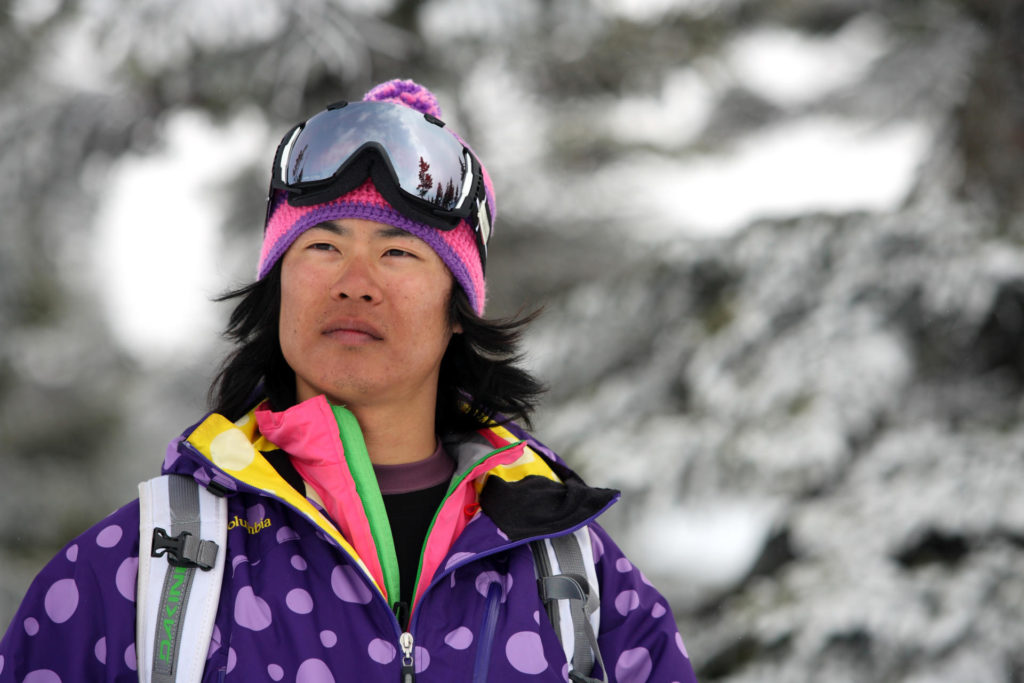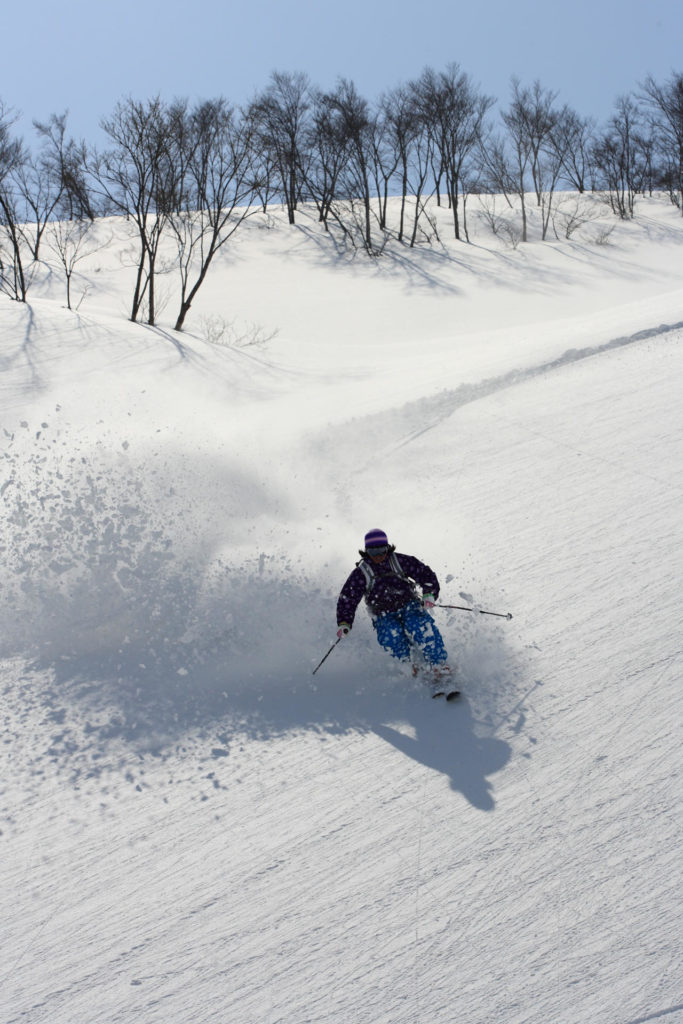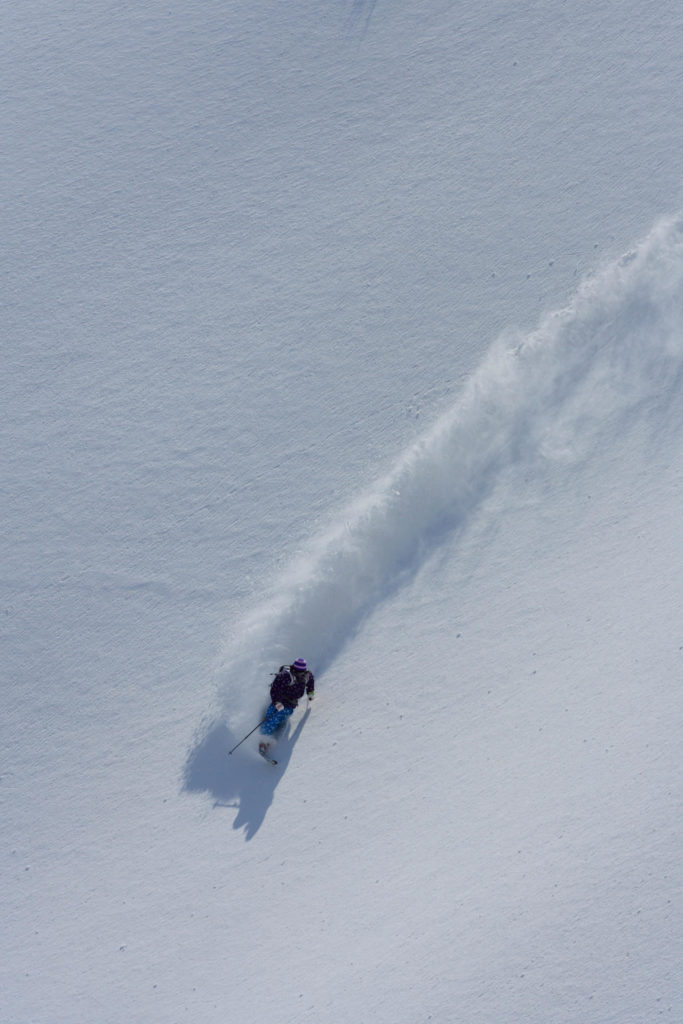Masanori Inagaki is unassuming when you first meet him; his words are soft, slow and measured; his clothes dark, reserved, slightly outdoorsy. When talking about skiing, however, he becomes animated. And when Inagaki is on the hill, he is a whole different person, dressed in loud, colorful check or polka-dot pants and an equally aggressive jacket, head topped off by one his girlfriend’s bright hand-knitted hats. He literally explodes off jumps and screams down big mountain slopes. He’s the kind of skier others watch, mouths open, and he does it all riding skis that don’t even fasten down at the heel.

Inagaki is a telemark skier. A highly proficient practitioner of an old style of skiing he’s helping make modern. Telemark skiers, for the uninitiated, ride alpine-like skis, but with bindings that only attach at the toe, most often with a cable stretching around the back of the boot.
Consequently, telemark turns involve technique in which the outside leg remains in a normal, flexed position while the inside, or rear, leg drops down and back into a kneeling position, with the heel raised. The result, done well, is an elegant, smooth turn. Sometimes, as in Inagaki’s case, combined with jumps, slides, turns, grabs and anything else a freestyle skier could think of.
Right on the edge of 30, he’s at the peak of his sport, as famous as one can get in the still small telemark world. He has sponsorship contracts with big names such as Atomic, Garmont, Columbia Sports, Smith Optics and Hestra; regularly appearing in Japanese ski magazines, videos and catalogues.
He was the poster boy, and one of the on-snow demonstrators, for last year’s Telemarkuri (“tele’s” biggest event in Japan). While it hasn’t made him wealthy by any means—summers are usually spent grooming golf greens rather than cutting corduroy on some Southern Hemisphere piste—he is a good example of the Japanese school of ski bumming and representative of the art of telemark skiing itself.

Raised in Yokohama, Inagaki grew up skiing, like most city kids, on weekends and holidays. But when all his friends headed for university, he made perhaps a more Western-minded decision—or more accurately, a non-decision.
“I just was thinking about what to do with myself,” he says. “I was really into mogul skiing—that’s about all I did. And it was the time of the Nagano Olympics, so I was thinking about just skiing.”
A fortuitous meeting with Tomoyuki Tabata, now owner of the Bottom Line ski tuning shop and at the time working for SOS in Jiyugaoka, planted the seed. “He was talking about going skiing, and I said I’d be in Zermatt, Switzerland, that winter, so why not come on over,” Tabata says. “I figured at least that way he’d know somebody.”
There was one other thing Tabata gave to the younger skier when he did in fact decide to go to Europe in 1996: an introduction to telemark skiing. “I was just getting started on telemarking—big long, skinny skis and leather boots—and he was pretty much only skiing bumps, but he got interested,” Tabata says.
“I had no idea what telemark skiing was, except it wasn’t exactly cross-country, and it wasn’t snowboarding,” Inagaki says. So, he found a pair of two-meter-long skis (despite being less than 170 cm. tall) equipped with some battered Riva bindings. “I was only in Zermatt for about a month, but right about the time I got there, I found a pair of leather boots somebody had thrown away outside a shop.
“Well, I’m pretty sure somebody threw them away,” he laughs, adding they were so beat up they should have been in the garbage. “They were a little small, but I took them out two or three times, then switched to plastic boots (which were becoming more widely used).”
He discovered something else aspiring telemarkers soon learned, especially in the days of long, straight skis and floppy boots: “I couldn’t ski at all,” he laughs. “I couldn’t make a turn, and I didn’t have any textbook to read. But I did meet a lot of Swedes who were telemarking, and I sort of watched what they were doing.”
The real revelation came when he had the chance to see a ski video being filmed in Zermatt with famous big mountain skier Seth Morrison. “I watched Morrison come down taking this really nice line and jump off a mushroom,” Inagaki says.
“Then this other guy, Mark Peterson, came down on telemark gear and skied the exact same line. I thought that was really kakoii—it was like, ‘So that’s telemark skiing.’ You can jump off stuff with these skis.” Thus the addiction began.
For the next five years, he settled into the ski bum routine: work hard in summer, ski hard and live dirtbag in winter. “I was in Zermatt for five more seasons,” he says. “I never learned any German, because English was the common language among all these people from all over the world. There were tourist bars I couldn’t afford, and the ski bum bar where you could get a beer for about ¥180. I could speak enough English to order a beer and talk about skiing.”
During his second season in Zermatt, money was still tight, but his one pair of fresh skis for the year were given telemark, not Alpine, bindings (and, until last year, he never went back to Alpine). “Telemark skis were getting bigger, so it was a lot more fun to ski in powder,” Inagaki says.
“When everybody went out skiing, I could pretty much follow along. When I first got to Europe, I only thought about moguls, but when I switched to telemark, everything became fun—flats, bumps, powder, trees…everything. And I sort of got better, and every day I was skiing somewhere I couldn’t the day before, so I could see an improvement.”
So could John Wilhelmsson, one of the group of Swedes Inagaki befriended in Zermatt. “He had been a pro skier himself, but his body was pretty beat up, so he moved into photography,” Inagaki explains. Wilhelmsson invited the young Japanese to do some shooting, the results of which are still on the photographer’s site (tragically, he was killed in an avalanche in Zermatt in 2006).

The small bit of exposure gained from those initial photos slowly grew when he finally returned to Japan. “At some point, I discovered I was better at telemark than I ever would be with Alpine skis,” Inagaki says.
“Telemark is easier. I started by working at Hachimantai (Iwate), then going to Zermatt for the spring, then the next year to Niseko and Myoko before going back to Europe for the late season there. I started getting into magazines here, picked up some sponsors—I really worked at that, though—got into brochures, started getting asked to ski at events.”
He started doing this at a good time in telemark’s history in Japan. Around 2000, changes in gear and the arrival of the “Unparalleled” series of telemark-only videos from the U.S. completely changed the prevailing image of telemark skiing.
No longer wooly hippies deep-knee bending through wobbly turns on skinny skis, hands high overhead, the new breed of telemark skiers used big boots and wide skis to slide everywhere fixed-heel skiers and snowboarders could, and with the unique, graceful style of the sport.
The videos added the hitherto-shocking idea that telemarkers could in fact do the full range of freestyle moves and aerials as Alpine skiers do—and that the heel of the boot rising off the ski just made things more visually interesting.
Japan had its own famous names, notably Yutaka “Naccy” Takanashi and Hideyuki “Hide” Nagashima, both of whom appeared in the “Unparalleled” videos, along with the slightly younger Hiromichi Kuga, all three masters of smooth big-mountain, big-line skiing. Kuga in particular continues to appear in magazines and brochures, but all of these skiers are near or in their 40s.
Many people mention Masato Hirase, a high-flying, freestyle telemarker from Hakuba in his early 20s as someone to watch, and there certainly are a number of good telemarkers across the country. With his unique look and aerial style, Inagaki seems to have found his special niche in a sport that is thriving but has perhaps a less-defined image and vibe than it did even five years ago.
“A few years ago it was places such as Niseko and Myoko where you’d see really good telemarkers, and it was kind of unusual, but now it’s fairly normal to see freeheelers,” Tabata says. “Maybe the surprise factor isn’t there any more, and more people are skiing telemark today.
“But there are a lot of people who still think telemark means dropping your back knee way down, which looks as if it is tiring—and it is. The modern style is more upright and a lot easier on the knees, but people may not know that, and they might never even think of trying it.”
Inagaki says he’s ready to do his part. “I always wanted to promote telemark skiing to non-skiers or non-boarders,” he says. “Atomic helped me with skis for rental, and they put together a package where people get a lesson when they buy skis. So about two years ago, I more or less made Myoko my center, and I do lessons, although I haven’t established a school or anything like that.
“I’m not interested in things such as racing or even backcountry, really—those are not the images I’m trying to project.” The bright clothes are definitely part of it, he says: “I want to do something bold and exciting, and I want to have that look, too.
“When you ski or board, you want to fly, you want action. So it’s not strange to want to wear exciting clothes and do something exciting. That’s what I learned in Zermatt, and it’s what I want to do here, too.”

TELEMARK SKIING
Telemark Roots
You may have first heard the word “telemark” used in ski jumping, because it is the position, one ski in front of the other, in which ski jumpers attempt to land (if they want the best possible style points). In fact, the first “tele” turn was made in a ski jump competition in 1868.
Sondre Norheim, from the town of Morgedal in Telemark, Norway, wowed the crowd at a jump contest, not only by having the best jump, but also by using the one-ski-back, one-ski-forward position to land and then turn to stop. Norheim is often credited as the man who codified modern skiing. He’s credited, not only for the telemark turn, but also the Christiana turn, the move named after the old name for Oslo that is the root of the Alpine turn.
Norheim also shaped skis and cable bindings and, even today, practitioners say, it is that fore-aft stability that makes the telemark turn something special, a smoothly longboard-surfing-style alternative to the more difficult edge-to-edge style of Alpine skiing.
Since the two-piece clamp-down bindings that are the standard in today’s skiing have only been around since the late ’60s, telemark skiers really are harking back to the roots of modern skiing with the toe-only system.
Free Your Heel
The good news is that, compared to just a decade ago, improvements in both telemark gear and teaching make it a lot easier to master the challenging dance of not only shifting weight from one ski to the other, but also changing the “lead ski,” the downhill ski in front. Today’s plastic boots are more comfortable and provide more power than their leather predecessors, and skis go as wide as the fattest powder Alpine ski.
At the same time, many are also rediscovering some of the fun of skinny skis and ultra-light boots, but usually after gaining a good footing in the basics of the telemark turn. In fact, the concept of telemark is broad enough that you really don’t have to be going down too steep a slope.
Classic long, straight telemark skis are broader than cross-country skis and are equipped with the simplest possible telemark bindings—a rattrap-type affair that literally clamps the extended toe of the traditional telemark boot in place. These are a great alternative to snowshoeing and a lot more fun on the downhill return.
Free Your Mind
Going for a walk in the woods on telemark skis, in fact, isn’t a bad way to get started in the sport. The trick is to develop a natural, relaxed position with flexed ankles and knees—something not always easy to do on a pressured-filled first lesson on a groomed slope.
The idea is to have the weight firmly over the ball of the front foot, with the ankle flexed, not stretched forward; the femur of the rear leg should be vertical, so the skier’s weight is also transmitted down onto the rear ski. While the weight distribution isn’t always 50-50, it’s the simultaneous weighting of both skis that is the secret to the smoothness and unique feel of the “tele” turn.
With today’s skis and boots, the skier doesn’t have to sink down until the kneecap of the rear leg is almost touching the ski; a higher, more natural, athletic stance not only looks a lot better than crouching low with hands overhead, but it also will keep thigh muscles and knees from burning up and allow for longer days in the powder.
That’s where “free heel” skiing really comes into its own. In deep powder, the telemark skier simply starts moving forward and makes the lead change to initiate the first turn—no mad jumping from edge to edge or exaggerated bouncing.
The best way to get good quickly, of course, is through a professional ski school. It is hard to believe that just 23 years ago the Telemark Association of Japan (TAJ) approached a group of Telemark skiers in Myoko, Niigata, about establishing the first accredited telemark school in Japan. Today, instructional centers are found across the country.
The TAJ Website ( www.ski-taj.org/School/school.html) provides a list of accredited schools. Or just talk to a telemark skier you might meet on the slopes. It’s still a small sport, and practitioners tend to be friendly and more than welcome to share information with those interested in free heel skiing.





